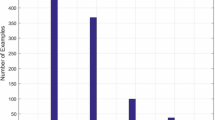Abstract
We show a simple and explicit reduction of the problem of the existence of positive solution of a system of real algebraic homogeneous inequalities in \( R_{ + }^{n} \) to solvability of a standard concave programming problem, which in turn is equivalent to checking whether a particular constraint of a finite system of convex inequalities is redundant. We illustrate this result on two well-known problems in mathematical economics: the weak separability problem and the collective consumption behavior for the homogeneous utilities.
Access this chapter
Tax calculation will be finalised at checkout
Purchases are for personal use only
Similar content being viewed by others
References
Kondrakov, I., Pospelova, L., Shananin, A.: Generalized nonparametric method. Applications to the analysis of commodity markets. Proc. MIPT. 2, 32–45 (2010)
Petrov, A., Shananin, A.: Integrability conditions, income distribution, and social structures. In: Tangyan, A., Gruber, J. (eds.) Constructing Scalar-valued Utility Functions. LNEMS. vol. 453, pp. 271–288. Springer (1998)
Klemashev, N., Shananin, A.: Inverse problems of demand analysis and their applications to computation of positively-homogeneous Konus–Divisia indices and forecasting. J. Inverse Ill-Posed Prob. 24(4) (2015). https://doi.org/10.1515/jiip-2015-0015
Afriat, S.: The construction of utility functions from expenditure data. Int. Econ. Rev. 8(1), 66–77 (1967)
Varian, H.R.: Non-parametric tests of consumer behaviour. Rev. Econ. Stud. 60(1), 99–110 (1983)
Blackorby, C., Primont, D., Russel, R.: Duality, Separability, and Functional Structure: Theory and Economic Application. North-Holland, Amsterdam (1979)
Cherchye, L., Demuynk, T., De Rock, B., Hjertstrand, P.: Revealed preference tests for weak separability: an integer programming approach. J. Econom. 186(1), 129–141 (2015)
Fleissig, A., Whitney, G.A.: A nonparametric test of weak separability and consumer preferences. J. Econom. 147(2), 275–281 (2008)
Swofford, J.L., Whitney, G.A.: A revealed preference test for weakly separable utility maximization with incomplete adjustment. J. Econom. 60(1–2), 235–249 (1994)
Echenique, F.: Testing for separability is hard. arXiv:1401.4499 [ cs.GT]
Chiappori, P.: Rational household labor supply. Econometrica 56(1), 63–90 (1988)
Talla Nobibon, F., Cherchye, L., Crama, F., Demuynk, T., De Rock, B., Spieksma, F.: Revealed preference tests of collectively rational consumption behavior: formulations and algorithms. Oper. Res. 64(6), 1197–1216 (2016)
Smeulders, B., Cherchye, L., De Rock, B., Spieksma, F.C.R., Talla Nobibon, F.: Complexity results for the weak axiom of revealed preference for collective consumption models. J. Math. Econ. 58, 82–91 (2010)
Talla Nobibon, F., Spieksma, F.: On the complexity of testing the collective axiom of revealed preference. Math. Soc. Sci. 60(2), 123–136 (2010)
Acknowledgements
The first author is partially supported by Russian Foundation for Basic Research, project No. 17-51-150001. The second author is partially supported by Russian Foundation for Basic Research, project No. 17-0700300.
Author information
Authors and Affiliations
Corresponding author
Editor information
Editors and Affiliations
Appendix
Appendix
Proposition 1
The complete PH-separability holds if and only if the system of (4)–(6) is consistent.
Proof
At first, recall that Euler’s homogeneous function theorem can be reformulated as follows for the case of PH well-behaved functions \( f\left( \cdot \right):R_{ + }^{n} \to R_{ + } \). If \( x_{0} \in R_{ + }^{n} \) and \( p \in \partial f\left( {x_{0} } \right) \), i.e. p belongs to a supergradient set of \( f\left( \cdot \right) \) at x0, then \( px_{0} = f\left( {x_{0} } \right) \). Indeed, it follows from concavity of \( f\left( \cdot \right) \) that the inequality \( f\left( x \right) - f\left( {x_{0} } \right) \ge p\left( {x - x_{0} } \right) \) holds for all \( x \in R_{ + }^{n} \). Let \( x =\uplambda\,x_{0} ,\;\uplambda > 0 \). As \( f\left( \cdot \right) \) is positive homogeneous, then for all positive λ it holds that \( \left( {\uplambda - 1} \right)f\left( {x_{0} } \right) \geq \left( {\uplambda - 1} \right)px_{0} \), hence, \( px_{0} = f\left( {x_{0} } \right) \).
Necessity. Assume that statistics is complete PH-separable. By definition it means that there exists a pair of a well-behaved PH functions \( u_{0} \left( {q,z} \right) \) and \( u_{1} \left( y \right) \) such that
As PH well-behaved functions are monotonic, then it follows from (11) that
Define the Young transforms:
By definition it holds
Now necessity follows as \( \uplambda_{t} = \frac{1}{{v_{1} \left( {x^{t} } \right)}},\;\;\upmu_{t} = \frac{1}{{v_{0} \left( {p^{t} ,v_{1} \left( {x^{t} } \right)} \right)}},\;\;t = 1, \ldots ,T \) are solutions of the system of (4)–(6).
Sufficiency. Set \( u_{1} \left( y \right)\mathop = \limits^{\text{def}} \hbox{min} \left( {\uplambda_{t} x^{t} y\left| {t = 1, \ldots ,T} \right.} \right) \). By homogeneous Afriat’s theorem it holds \( \left( {y^{t} } \right) \in {\text{Arg}}\;\hbox{max} \left\{ { u_{1} \left( y \right) \left| { x^{t} y \le x^{t} y^{t} } \right.,\;\;y \ge 0} \right\} ,\;\;t = 1, \ldots ,T \).
Set \( u_{0} \left( {q,z} \right)\mathop = \limits^{\text{def}} \hbox{min} \left( {\upmu_{t} \left( {p^{t} q + \frac{1}{{\uplambda_{t} }}z} \right)\left| {t = 1, \ldots ,T} \right.} \right) \).
Let \( q \ge 0,\;\;y \ge 0,\;\;p^{t} q + x^{t} y \le p^{t} q^{t} + x^{t} y^{t} \). Then it holds
And it follows that \( u_{0} \left( {q^{t} ,u_{1} \left( {y^{t} } \right)} \right) \ge u_{0} \left( {q,u_{1} \left( y \right)} \right) \) and, thus, (11) holds.
Rights and permissions
Copyright information
© 2019 Springer Nature Switzerland AG
About this paper
Cite this paper
Shananin, A., Tarasov, S. (2019). Positive Solutions of Real Homogeneous Algebraic Inequalities. In: Petrov, I., Favorskaya, A., Favorskaya, M., Simakov, S., Jain, L. (eds) Smart Modeling for Engineering Systems. GCM50 2018. Smart Innovation, Systems and Technologies, vol 133. Springer, Cham. https://doi.org/10.1007/978-3-030-06228-6_4
Download citation
DOI: https://doi.org/10.1007/978-3-030-06228-6_4
Published:
Publisher Name: Springer, Cham
Print ISBN: 978-3-030-06227-9
Online ISBN: 978-3-030-06228-6
eBook Packages: Intelligent Technologies and RoboticsIntelligent Technologies and Robotics (R0)




